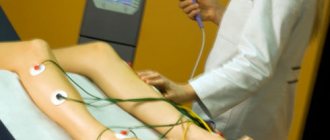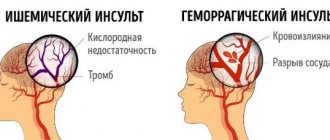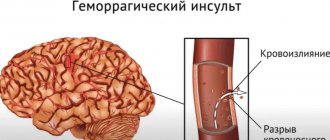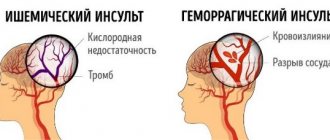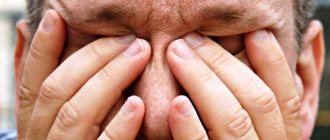Hemorrhagic stroke is a cerebral hemorrhage that has consequences of varying severity and duration. This pathology poses a serious threat to human life. After a long crisis, irreversible brain damage occurs. Regardless of the course of the disease and the severity of the consequences, long-term recovery is required. It is better to carry out rehabilitation after a hemorrhagic stroke in a department or special rehabilitation centers. They employ doctors of the highest category who control the speed and quality of the patient’s return to a normal lifestyle and adaptation to new conditions.
Mechanism of occurrence and types of hemorrhagic stroke
A stroke is an acute cessation of blood supply to tissues. This condition leads to necrosis of nerve cells, which are slowly restored and cannot perform their usual functions. The most common type is ischemic stroke - neurons are deprived of oxygen due to blockage of arteries and other vascular pathologies. Hemorrhagic stroke is more life-threatening and is associated with vascular rupture and subsequent hemorrhage. Its severity depends on the location of the damaged area, the caliber of the vessel and other factors, including the age of the patient.
Hemorrhagic strokes are usually classified according to the place of their occurrence. So, there are several main varieties:
- parenchymal - occurs directly in nerve tissues;
- intraventricular - hemorrhage into the cavity of the ventricles of the brain;
- subdural - blood enters under the dura mater of the brain;
- epidural - the focus is localized above the hard shell;
- subarachnoid - hemorrhage between the arachnoid and pia mater of the brain.
When blood enters nerve tissue or the cavity of the brain, hematomas of various sizes are formed. Their appearance causes tissue swelling, which puts pressure on neurons. If there is no blood supply, they die. As a result of necrosis of nerve cells, there is a loss of vital skills, a sharp deterioration in health, and the risk of developing coma remains. In addition, the acute period is dangerous and fatal, and during the rehabilitation process a recurrence of stroke is possible.
Side effects of stroke in the right and left hemisphere
The severity of symptoms of a hemorrhagic stroke depends on which parts of the brain are affected. Each half of the brain controls the opposite side of the body. Thus, a stroke to the right side of the brain results in damage to the left side of the body.
Consequences if a hemorrhagic stroke occurs - right side:
- left-sided weakness or paralysis, sensory impairment;
- vision problems, including inability to see in the left visual field of each eye;
- spatial problems with perceiving directions, such as up or down, forward or backward;
- inability to recognize body parts;
- inability to find objects such as clothing or toiletries;
- memory problems;
- behavioral changes such as lack of concern for situations, impulsivity, tearfulness and depression.
Consequences if a hemorrhagic stroke occurs - left side:
- right-sided weakness or paralysis, sensory impairment;
- problems with speaking and understanding language (aphasia);
- vision problems, including inability to see the correct field of vision in each eye;
- impairment of the ability to count, reason and analyze objects;
- behavioral changes such as depression, caution, and indecisiveness;
- impairment of the ability to read, write and learn new information;
- memory problems.
Possible causes of the attack
Hemorrhagic stroke has an acute onset. It is difficult to determine its cause, especially in the absence of a history of heart and vascular diseases. Up to 15% of cases remain unrecognized, and in a quarter of patients, hemorrhage begins without a clear cause. During the diagnosis, a rupture of the vessel is noted, and the provoking factor remains the goal of further examinations. This is necessary to prevent further relapses. In general, there are several conditions that can provoke a hemorrhagic stroke:
- chronic increase in blood pressure;
- diabetes;
- lipid metabolism disorders;
- heart and vascular diseases, including atrial fibrillation, stenosis (narrowing) of the carotid arteries, anemia;
- unhealthy lifestyle, bad habits, excess weight.
Arterial hypertension is the most common cause of hemorrhagic stroke. With a chronic increase in pressure, the strength and elasticity of the vascular walls decrease and the properties of the blood change. Patients of the Clinical Brain Institute often complain of pressure surges, but have no idea what consequences this condition can lead to. Rapid blood filling of the vessels causes their rupture with subsequent hemorrhage into the brain tissue.
Metabolic disorders also affect the condition of the vascular walls. One of the most common forms of dyslipidemia (pathologies of fat metabolism) is the accumulation of excess cholesterol. It forms deposits on the walls of the arteries, causing them to become brittle and unable to withstand stress. This condition provokes the development of atherosclerosis, a disease that is accompanied by a decrease in the elasticity of the arteries. This disease is often diagnosed as a precursor to hemorrhagic stroke.
Another pathology that can lead to spontaneous hemorrhages is diabetes mellitus. Frequent fluctuations in blood glucose levels irritate the inner lining of the walls of blood vessels, which causes their fragility. Additional factors, including surges in blood pressure, cause rupture of arteries in any area. If the process is localized in the brain area, it is dangerous with serious complications.
The lifestyle and age of the patient also affect the condition of blood vessels and the chemical composition of the blood. Only with regular physical activity is normal blood circulation possible. Sedentary work, poor diet, alcohol abuse and smoking are the main causes of increased blood viscosity, blood clots, atherosclerosis and other vascular diseases. In such conditions, strokes can occur for no apparent reason, with a slight increase in pressure.
Causes
Hemorrhagic stroke is poorly diagnosed, although the causes and mechanism of its development are well studied. Various factors can provoke the development of hemorrhoidal stroke:
- Hypertension, arterial hypertension.
- Vascular aneurysm.
- Long-term use of anticoagulants.
- Diseases of the brain, spinal cord, cardiovascular system, diabetes.
- Congenital vascular defects.
- Blood diseases.
- Systemic diseases.
- Kidney and liver diseases.
- Alcoholism, drug addiction, tobacco addiction.
- Obesity.
- Stress.
- Hard physical labor.
- Hereditary predisposition.
A persistent increase in blood pressure leads to the formation of fibrinoid-hyaline necrosis of the walls of arterial vessels and can cause rupture of the walls of the aneurysm and the development of bleeding. The hematoma compresses the surrounding brain tissue, causing brain swelling. Blood from ruptured vessels can permeate the nerve tissue of the brain or, under pressure, break into the ventricles of the brain, the subarachnoid space.
Clinical picture
At the first symptoms of a hemorrhagic stroke, it is important to begin treatment immediately. This is an acute condition that does not go away without symptoms. In most cases, the patient experiences a sharp deterioration in health, and loss of consciousness may occur.
The first symptoms of hemorrhagic stroke
The first manifestations of a stroke may differ, depending on the volume of the hematoma and its location. The task of loved ones is to identify them at an early stage and call a medical team for urgent hospitalization of the patient. Experts from the Clinical Brain Institute advise you to familiarize yourself with the main symptoms that may indicate acute cerebrovascular accident:
- tingling sensation of the skin, numbness of part of the face;
- nausea and vomiting;
- headaches, as well as soreness in the eye area and behind the eyes;
- impaired motor coordination;
- rapid pulse;
- paresis and paralysis of muscles in any part of the body, most often the process is one-sided.
These symptoms are typical if the patient remains conscious. Fainting is a common sign of a hemorrhagic stroke, and it is strictly forbidden to try to revive the person. There are several phases of consciousness regression - the prognosis for each of them will also be different:
- stunning - minor changes in which the victim is poorly aware of what is happening and practically does not react to others;
- somnolence - lack of response to external factors, while the eyes remain open, breathing and heartbeat are normal;
- stupor - a condition that resembles sleep, with preservation of the swallowing reflex and the reaction of the pupils to light;
- coma is a complete lack of reaction to what is happening; the patient’s vital activity is supported by special equipment.
Various disturbances of consciousness are present in almost all patients, say experts from the Clinical Brain Institute. Based on their condition, it is already possible to preliminarily predict their chances of recovery. Thus, if consciousness is maintained, the probability of death remains within 20%, with stunning - up to 30%, with somnolence - up to 55%, with stupor - up to 85%. With the development of coma, the prognosis is questionable - survival rate is no more than 10%.
Signs of the acute phase of stroke
The clinical picture of stroke includes several main syndromes. They are a consequence of acute cerebrovascular accident and occur when neurons die. These syndromes suggest a hemorrhagic stroke, even if the patient is conscious:
- anisocoria - the patient’s pupils are dilated unevenly and have different sizes;
- decreased severity of reflexes, including a slower reaction of the pupils to bright light;
- the appearance of an oculocephalic reflex - if a patient in a coma turns his head to the side, his pupils shift in the opposite direction;
- bulbar syndrome - decreased tone of the chewing, swallowing muscles and tongue, which is manifested by corresponding symptoms;
- pseudobulbar syndrome - a violation of swallowing, chewing and speech while maintaining the tone of the corresponding muscles.
Immediately after a hemorrhagic stroke, it is difficult to predict the likelihood of full recovery. The patient’s condition can only be determined dynamically, so the patient spends the first time under 24-hour medical supervision. The fact is that during the course of the disease there are often several critical periods during which the likelihood of relapse is increased. The first of them occurs on the second to fourth day after the attack, the next one appears 10-12 days later.
Period of return to normal life
Rehabilitation after hemorrhagic stroke is carried out according to plan in medical institutions of various specialties:
- For 1 month, patients are treated in the neurological or neurovascular department of the hospital.
- Then they receive rehabilitation treatment in the rehabilitation department for another 1 month.
After this, doctors evaluate how successful the treatment was. Depending on the preliminary results, the patient is offered different programs for further recovery.
Diagnostic methods
In the acute phase of a hemorrhagic stroke, the patient must be urgently examined to preliminarily determine the prognosis and select treatment tactics. The condition is complicated by the following factors:
- extensive hematoma in the brain tissue, which occupies an area of 7 square cm or more;
- large intraventricular hematomas - more than 2 square cm;
- high blood pressure;
- elderly age of the patient;
- any chronic diseases;
- presence of dislocation syndromes.
Dislocation syndromes are signs of an increase in the volume of the brain with a subsequent change in its localization in the skull. Using these symptoms, you can determine in which area the main pathological focus is located, as well as predict the chances of recovery. The primary diagnosis of strokes is based on the clinical picture, so dislocation syndromes play an important diagnostic role. In total, there are 9 options for how the brain matter can shift. However, when diagnosing strokes, 2 of them are most important.
Symptoms of hemorrhagic stroke
Subarachnoid hemorrhage is accompanied by severe headache, vomiting, convulsions may begin, consciousness is impaired, Terson syndrome is observed, and meningeal symptoms appear. Parenchymal stroke is characterized by unexpectedly occurring severe headache, pallor or redness of the face, asymmetry of facial features, impaired coordination of movement, impaired respiratory function, and agitation. Ventricular stroke, the most severe form of the disease, is characterized by rapid deterioration of the patient's condition; bloody vomiting, loss of consciousness, fever, convulsions, and coma may occur. Ventricular stroke most often leads to the death of the patient. In most cases, hemorrhagic stroke occurs during the daytime, and the patient suddenly loses consciousness.
At the first examination, doctors note a change in complexion, high blood pressure, impaired respiratory function, slow pulse, decreased muscle tone, and tendon reflexes. Such symptoms are characteristic of the first hours after a stroke, then an increase in muscle tone and tendon reflexes occurs, the function of the pelvic organs is disrupted, the condition worsens, and the patient may fall into a coma.
Make an appointment
Treatment tactics
The treatment regimen is selected individually, depending on the examination results, the general condition of the patient and other factors, including age and concomitant diseases. The Clinical Brain Institute is a staff of professionals who will help you choose the right treatment regimen and will accompany the patient at all stages of treatment and rehabilitation. In case of stroke, conservative methods or surgical intervention may be recommended.
Conservative methods
In the acute period of hemorrhagic stroke, it is important to regulate blood pressure, as well as restore the level of blood circulation in the nerve tissues. This process is controlled by the systemic use of drugs from different groups:
- hypothetical agents for lowering blood pressure levels;
- potassium antagonists;
- antispasmodics and painkillers;
- sedatives;
- hemostatic drugs;
- antiprotease and antifibrinolytic groups;
- vitamin complexes;
- diuretics to prevent brain swelling;
- blood plasma substitutes.
Drug therapy is possible only if the size of the hematoma does not interfere with the normal functioning of the brain. As soon as the patient's condition becomes stable, measures can begin to restore lost skills. If with ischemic strokes this possibility appears within a few days after the attack, then after a hemorrhage in the brain the process takes longer.
Surgical treatment of hemorrhagic stroke
Surgery is performed to remove large hematomas that are preventing normal recovery. The operation is complex, so it is prescribed only in cases where conservative methods do not bring results. Thus, the size of a hematoma of 30 ml or more is considered critical - such a volume does not resolve on its own. Surgery is also recommended for hemorrhages in the cerebellar area, which are manifested by severe neurological symptoms. There are two methods of performing the operation: with access using classical and endoscopic methods.
Experts from the Clinical Brain Institute advise you to accept the decision voiced by your attending physician. If full treatment and rehabilitation are impossible without surgery, it is better to carry it out using endoscopy. However, there are also contraindications to surgery. These include medial hematomas and the patient being in a state of deep coma - in both cases, the risk of death during surgery is up to 100%.
First aid for hemorrhagic stroke
Having identified the symptoms of a stroke in a person who is next to you, try not to panic and use the following algorithm:
- assess your general health: breathing, level of consciousness, heart rate, blood pressure;
- identify obvious signs of a stroke (read about the FAST test below);
- call an ambulance;
- try to find out the circumstances of the deterioration in health if the patient is able to communicate;
- place the person correctly - on his side, bending his upper leg at the knee;
- take care to create conditions in which sufficient oxygen will be supplied;
- Monitor the patient’s condition until medical workers arrive and arrange for his transportation to the nearest hospital.
FAST test
It explains the obvious signs of a stroke and helps to quickly understand that a person has had a “stroke”:
Face
The face becomes weak or sagging, the effect is usually more noticeable on one side.
Arm
One arm becomes numb or weak, and it may be difficult to lift it.
Speech
It becomes difficult to speak, and the victim's voice becomes slurred.
Time to call (Time)
If any of the above are noticed, you should immediately call emergency services.
A hemorrhagic stroke is characterized by:
- weakness, loss of sensation in the arm, leg, most often on one side of the body;
- decrease or loss of vision;
- loss of speech and inability to understand someone else’s speech;
- Strong headache;
- loss of orientation and perception, loss of balance.
Rehabilitation and prognosis
It is impossible to recover quickly after a stroke. This process begins once the patient is stabilized and can continue for many years. Doctors at the Clinical Brain Institute are confident that no two cases of hemorrhagic stroke are absolutely identical, so an individual program must be developed for each patient. It will include medication support, as well as sessions with specialists and at home. It is important to gradually restore motor, speech and social function, self-care skills, as well as the patient’s intellectual abilities. Rehabilitation includes simple exercises that must be performed daily, constantly becoming more complex. The process can be lengthy—many patients are unable to get up and move independently for the first few years after a stroke. However, fine motor skills and the ability to care for oneself improve within the first months. It is also worth contacting specialists in therapeutic massage and rehabilitation physical education - such activities significantly speed up the recovery process.
Hemorrhagic stroke is a dangerous condition, the prognosis of which largely depends on the speed of medical care. It is worth understanding that full rehabilitation of the patient is possible only if the doctors’ orders are followed, independent work and the support of loved ones. Specialists at the Clinical Brain Institute are ready to develop an individual program for each person who has suffered a stroke, as well as examine them throughout the entire rehabilitation period.
Prevention and treatment of complications
Stroke patients are susceptible to many complications. These people typically have underlying medical conditions such as hypertension, diabetes, heart disease, or other illnesses that increase the risk of systemic medical complications during stroke recovery.
However, some complications may occur as a direct consequence of the brain injury itself, immobility, or stroke-related treatment. These events significantly impact the final outcome of stroke patients and often impede neurological recovery.
Brain swelling
Swelling or inflammation is part of the body's natural response to injury. Edema refers to swelling due to accumulated fluid. However, if swelling occurs in the brain, it can cause serious complications. Brain swelling can restrict blood supply to the brain, causing brain tissue to die.
Treatment:
- decrease in body temperature;
- elevation of the head position;
- relief of pain and cramps;
- sometimes a surgical operation in which part of the cranial bone is removed to avoid compression of the nerve tissue.
Inflammatory processes in the lungs
Pneumonia is one of the common complications of stroke. In the case of a stroke, problems swallowing can cause aspiration, the entry of food or liquid into the airways, which can lead to pneumonia. Therefore, working with a speech therapist and breathing exercises are the main methods of preventing inflammation in the lungs.
Treatment:
- Therapy is prescribed - antibiotics and other medications.
Urinary tract inflammation and urinary incontinence
After a stroke, the patient may experience problems with urination in the form of urinary retention or incontinence.
Treatment:
- antibiotics;
- anticholinergic drugs such as oxybutynin chloride, which are used to reduce urges and frequency;
- an external catheter (uro-sheath) in men or diapers in women;
- use of catheters.
Prevention of diaper rash and bedsores
For incontinence, it is important to choose the right diapers and pampers - according to size and absorbency. But sometimes these rules may not help, for example, when the patient has very thin skin. If the level of incontinence is low, then diapers can be replaced with pads.
When changing a diaper, be sure to treat the skin with a special protective cream to prevent diaper rash.
Thrombosis
If blood moves through the veins too slowly, a blood clot can form in the blood vessels. A case of thrombosis can become life-threatening if the clot breaks off and travels to a vital organ.
Thrombosis can occur from 2 weeks after a stroke due to prolonged immobility, previous surgery and other chronic diseases.
Treatment:
- exercise therapy;
- using elastic bandages or elastic stockings;
- antithrombotic therapy.
Prevention of thrombosis
To prevent the development of thrombosis, doctors recommend wearing compression stockings and prescribe medications. Also, for prevention, it is important to frequently change the position of the patient’s body.
The process of moving a person on a bed can be traumatic, so it is better to reduce the risks by using special means. For example, a ladder with soft crossbars will help the patient independently move around the bed - rise, sit down, move to the side, and a sliding transfer sheet will allow the caregiver to quickly and easily move the person to the head of the bed, turn on his side and move down the bed.
Stiffness in the joints
Due to forced immobility after a stroke, contractures may occur in the joints. Contracture is a loss of mobility over time due to abnormal shortening of soft tissue structures covering one or more joints. These include skin, ligaments, tendons, muscles and joint capsules.
Prevention:
- physiotherapy;
- massage.
How does pathology develop?
Translated from Greek, “hemorrhagic” means “bleeding”, and stroke is translated as “stroke”. During an attack, the liquid part of the blood leaves the vascular bed, accumulates and forms a hematoma, which compresses the neurons of the brain, which are injured and die.
During a stroke, there are two types of bleeding in the brain:
- Epithelial damage - usually occurs due to weakness of the vessel wall and increased pressure. The artery “bursts” under stress, the blood forms a pulsating hematoma, which presses on the brain tissue.
- Diapedesis is a pathological increase in the permeability of the vascular wall. The artery itself is not damaged, but its lining allows blood cells to pass through, which accumulate and form a hematoma.
Why is a stroke not always fatal?
With hemorrhage, the risk of mortality is very high - about 70%. The survival of the remaining patients is explained by the following points:
- Area of damage - much depends on where the hematoma is located (vital centers, peripheral areas or lining of the brain). In some cases, a person’s lungs may fail, in others, coordination, vision or hearing will only decrease.
- Features of cerebral circulation - intracranial vessels are designed in a unique way, they reduce pulsation and ensure uniform blood flow. This slightly reduces the trauma to neurons caused by the growing hematoma.
- The presence of anastomoses is a bypass for blood circulation. When one vessel ruptures, some neurons receive nutrition through collaterals.
In most cases, the stroke clinical picture is the same, but with varying degrees of symptom severity. This is explained by the localization of hemorrhage and the death of specific neurons.
Diagnostics
To accurately identify the disease and differentiate hemorrhage from ischemia, an instrumental examination is performed:
- MRI or CT scan - the images show a limited area of the hematoma. The safety of magnetic tomography allows for multiple examinations and monitoring of neuronal recovery.
- Angiography - shows the condition of blood vessels. Well displays arterial rupture, signs of atherosclerosis and congenital anomalies.
- Lumbar puncture - taking cerebrospinal fluid in the lumbar region for analysis. The diagnosis of hemorrhagic stroke is made when red blood cells are detected in the cerebrospinal fluid in high concentrations.
Treatment after a stroke
A patient with a hemorrhagic stroke should receive first aid. The patient is placed on the bed, clothes are unbuttoned to make breathing easier, and a window is opened to allow fresh air to enter. The patient's head should be higher than the body level. The patient should measure blood pressure and pulse, monitor breathing in case of loss of consciousness and, if necessary, carry out resuscitation measures. The main task of doctors in case of hemorrhagic stroke is to stop bleeding, maintain respiratory function, the functioning of the cardiovascular system, and relieve cerebral edema.
In case of extensive hemorrhage in the brain, neurosurgical microtechnical operations are used - the hematoma is removed in order to reduce the pressure on the brain tissue and prevent the development of cerebral edema. Surgery for hemorrhagic stroke is performed strictly according to indications. Painkillers are prescribed to reduce headaches. If the cause of a hemorrhagic stroke was an aneurysm, doctors perform an operation and prescribe hemostatic drugs to stop the bleeding. Often, subarachnoid stroke is accompanied by vasoconstriction (secondary vasospasm) and the development of ischemic stroke. In this case, calcium channel blockers are prescribed to prevent narrowing and spasm of blood vessels.
Consequences
The consequences of a hemorrhagic stroke can bother the patient for the rest of his life. Depending on the severity of the disorders, recovery occurs; the most severe condition is in patients with extensive hemorrhagic stroke. Depending on which hemisphere of the brain is affected, the consequences of cerebral hemorrhage are observed. Hemorrhagic stroke of the right hemisphere of the brain:
- Partial or complete loss of vision.
- Disorders of urination and defecation.
- Paresis or paralysis of the body, decreased sensitivity of the left half of the body.
- Development of mental disorders.
A stroke to the left hemisphere of the brain causes paralysis on the right side of the body. When hemorrhage occurs in the area of the brain stem or cerebellum, loss of sensitivity occurs, the patient cannot swallow or speak, partial or complete loss of hearing in the right ear occurs, vision is impaired, coordination of movements is impaired, the patient cannot make unilateral or bilateral voluntary movements. Often the consequence of a hemorrhagic stroke is dementia (dementia), which develops gradually.
How to determine if you have a stroke?
Manifestations of the disease can be different, they depend on exactly where the vessel ruptured, where the blood accumulated and how the hematoma is located inside the tissue. It can exert different pressure on areas of the brain responsible for individual capabilities of the body, which causes variability in the signs of the disease.
Rupture usually occurs instantly, but the severity of the condition may worsen as a hematoma forms. In this case, one or several symptoms can be observed over time:
- My head suddenly started to hurt;
- dizziness occurred;
- the person lost consciousness;
- general weakness of the body;
- presence of nausea, vomiting;
- the pulse becomes uneven;
- convulsions may occur;
- difficulty breathing;
- the skin turns red.
If individual symptoms were noticed or the person’s general condition worsened, he should be urgently taken to the hospital.
Forecast
The prognosis for hemorrhagic stroke depends on the severity of brain damage and the time of seeking first aid. If the stroke was not extensive and did not affect the vital centers of the brain, timely assistance was provided - there is a chance to return to normal life. It is impossible to predict the patient’s life expectancy - the prognosis depends on many factors:
- Patient's age.
- Severity of brain damage.
- Concomitant diseases.
According to statistics, more than 30% of patients die within a few weeks after a stroke, more than half of patients die within a year, and more than 60% of patients become disabled. No more than 20% of patients can recover completely within a few years.
Effective rehabilitation programs have been developed and tested at the Yusupov Hospital. The recovery process after a hemorrhagic stroke is unpredictable, lengthy and difficult. You can get advice on the treatment and rehabilitation of a patient by calling the hospital.
Make an appointment

